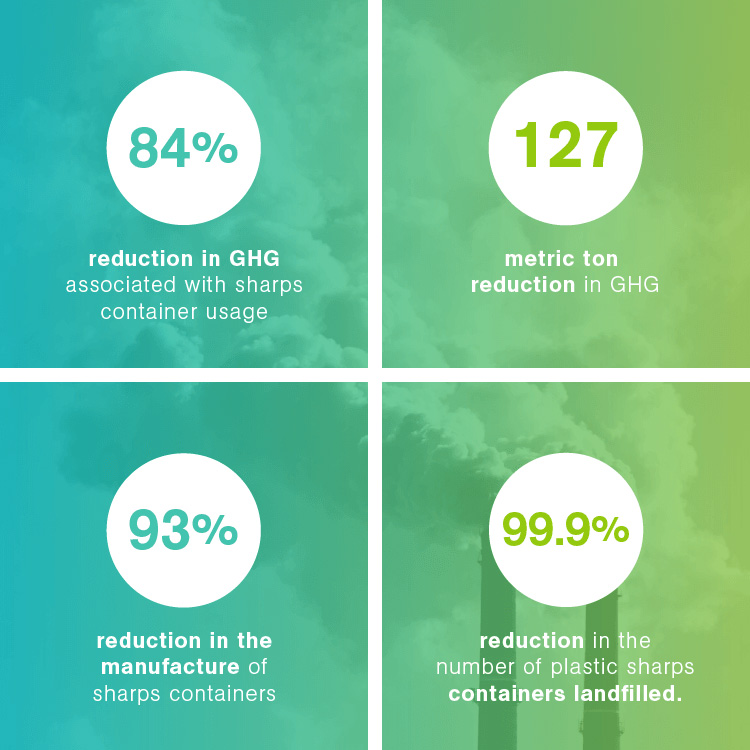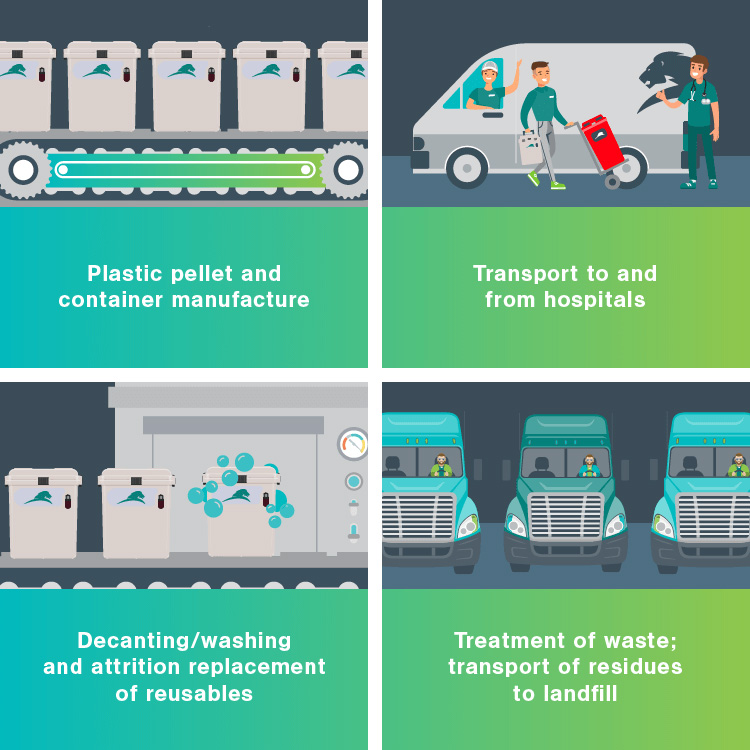Case Study: 84% Greenhouse Gas Emission Reduction with Reusable Sharps Containers

US Hospitals are striving to reduce their Greenhouse Gas emissions. Targeting supply chain points and replacing disposable with reusable items are among recommendations to achieve this. Annually US hospitals use 35 million disposable or reusable sharps containers generating Greenhouse Gas Emissions in their manufacture, use, and disposal. Northwestern Memorial Hospital recognized an opportunity to reduce their environmental burden through the introduction of reusable sharps containers across the hospital system.
So when single-use sharps containers are contributing heavily to Greenhouse Gas Emissions, how is that problem solved?
In this blog:
- The Challenge: Sustainability Gaps in GHG Emission Targets
- Our Approach: Conduct a Life Cycle Assessment of Impact
- The Solution: Replace disposable sharps containers with reusable containers
- The Results: 84% Greenhouse Gas Emission Reduction
"Sharps containment GWP in US hospitals totals 100,000 MTCO2eq, and if reusable sharps containers were used nationally the figure could fall by 64,000 MTCO2e"
Terry Grimmond and Sandra Reiner
Northwestern Memorial Hospital was struggling with the levels of GHG Emissions produced through the facility’s plastic dependency; one area that was contributing heavily to carbon footprint was the use of single-use sharps containers. Northwestern recognized that conversion from disposable sharps containers to reusable sharps containers, across every aspect of its manufacturing, transport and disposal, would significantly impact the systems’ environmental impact.
Using a life cycle assessment, global warming potential of a disposable sharps container and the Daniels reusable Sharpsmart container were assessed. Greenhouse Gas (GHG) emissions (C02, CH4, N20) were calculated in metric tons of carbon dioxide equivalents and calculated against the following:
- Plastic pellet manufacture and container manufacture
- Transport to and from hospitals
- Decanting/washing of reusables; attrition replacement of reusables
- Treatment of waste; transport of residues to landfill
Average CO2e was calculated over 2 years.
Data was analyzed using CHI2 and significance set at p ≤ 0.05.

Our solution to reducing the environmental impact of Northwestern Memorials' supply chain was our reusable, hands-free sharps container: The Sharpsmart.
All disposable sharps containers at Northwestern Memorial were replaced with reusable Sharpsmart sharps containers. The fill line capacity of the previously utilized disposable sharps containers was 10.9 Liters; Daniels reusable containers had a fill capacity of 18 Liters. Identical container exchange protocols were maintained, however the introduction of the reusable containers mitigated the assembly time and labor of the single use containers, as well as supply and recycling of the cardboard boxes in which the disposable containers were provided in.
From a production standpoint, reusable sharps containers were robotically opened, decanted and decontaminated and content autoclaved at the same factory and landfilled. The Sharpsmart reusable sharps container is certified for 500 uses with 2% of containers annually requiring dismantling and repair (with 80% of parts being reused and 20% recycled); the disposable containers were not subjected to any recycling or resource recovery initiatives with 100% of containers going to landfill after use.

With Daniels Sharpsmart, the hospital reduced its annual GWP by 127 MTCO2eq (-83.5%) and diverted 30.9 tonnes of plastic and 5.0 tonnes of cardboard from landfill. Using Sharpsmart reduced the number of containers manufactured from 34,396 disposable containers to 1,844 reusable sharps containers in year 1 alone. The reduction exceeded the 2020 reduction target for US federal hospitals.
Results showed that in converting to the Sharpsmart reusable sharps container, annually the facility achieved:
- 84% reduction in GHG associated with sharps container usage
- 127 metric ton reduction in GHG
- 93% reduction in the manufacture of sharps containers
- 99.9% reduction in the number of plastic sharps containers landfilled.

54% of greenhouse gas emissions in hospitals are derived from supply chain goods and services.
The study indicates sharps containment GWP in US hospitals totals 100,000 MTCO2eq and if reusable sharps containers were used nationally the figure could fall by 64,000 MTCO2e.
Learn more about the Sharpsmart
Terry Grimmond* and Sandra Reiner^
*Grimmond & Associates New Zealand; ^Northwestern Memorial Hospital Chicago
An LCA of Disposable vs Reusable sharps container in a large US hospital. Waste Management and Research 2012;30:639-642
The published Peer Reviewed study can be found here



